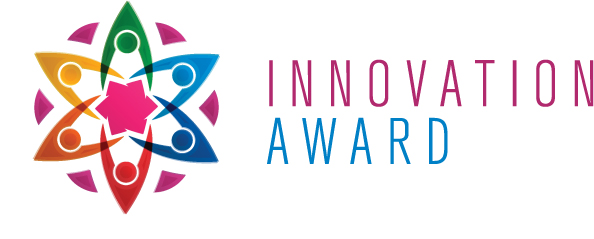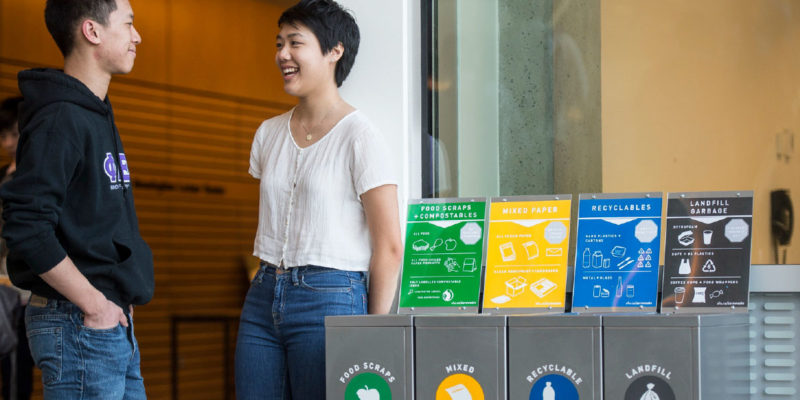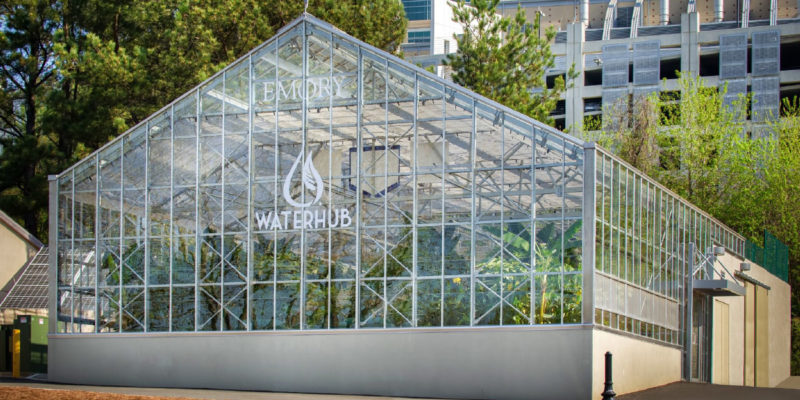
Simon Fraser University’s ongoing recycling campaign saves the institution money, meets environmental commitments, improves the campus aesthetic, and engages the community. Emory University’s WaterHub project converts toilet wastewater into a product that can be used for campus heating and cooling, while offering many other benefits.
Both initiatives, described in this article, received 2016 NACUBO Innovation Award honors for outstanding institutional innovation and achievement in two areas: (1) Process improvement at higher education institutions that have successfully re-engineered or designed a program that improves service delivery or administrative activity in response to a campus need; and (2) Resource enhancement at higher education institutions that have successfully reduced costs, increased revenues, or improved productivity in response to a campus need.
Business Officer will feature in upcoming issues the additional institutions that received Innovation Award honors in 2016 and were honored at the NACUBO 2016 Annual Meeting in Montréal.
Stop. Think. Sort.
At Simon Fraser University, a student sipping the last few drops of morning coffee is encouraged to “stop, think, sort” before tossing the cup in the trash. If it is paper, the coffee container goes in the green bin; Styrofoam belongs in the black bin.
The color-coded bins—there are four to choose from—are just one component of the zero waste initiative adopted by SFU with the goal of diverting 70 percent of waste from the landfill, while doubling the amount recycled or composted.

“Since its launch in January 2014, the initiative has diverted more than 1,600 tons of waste from the landfill, reducing methane gas emissions and saving about $180,000 (Canadian) in landfill fees,” says Martin Pochurko, SFU vice president, finance and administration, Burnaby, British Columbia. He adds that this figure does not account for disposal fees/rebates for other material streams.
“When we started this project, it was one of the key priorities of our community,” explains Candace Le Roy, SFU’s director of the sustainability office. “Students, staff, and faculty really wanted the university to take a leadership role in diverting waste from landfills, where valuable raw materials are left to rot and pollute. It was neither environmentally nor economically sound to continue sending our waste to landfills.”
To develop the program, SFU sustainability staff first consulted with Metro Vancouver and universities facing similar challenges, and then formed a partnership with the university’s facilities services.
“We developed a business plan that demonstrated the case for an overhaul of how we collected and distributed our waste that was discarded by users,” Le Roy says. “Although it required a significant, but not cost-prohibitive, upfront investment in staff time and materials, we were confident that the payoff of the implemented program would be well worth it.”
Improving Campus Aesthetics
The project passed the litmus test on a number of levels, including achieving cost savings from tipping fee reductions and janitorial efficiencies, meeting environmental commitments, improving the campus aesthetic, and engaging the community. “Because the project had wins in so many areas,” Le Roy says, “we not only received the full buy-in from our senior leadership team, but we also attracted some strong partners.”
The aesthetic benefit, she explains, was to ensure that the waste collection infrastructure across the campuses added to, rather than took away from, the efforts to modernize and tidy up the institution’s common spaces.
“The recycling/garbage system at the university at that time was quite haphazard,” Le Roy explains. “There were random types and colors of bins all over the place. It was messy. Our campus planners were really interested in standardization, modernization, and the cleanup of the aesthetics of waste management across the institution.”
In addition, the signage across the three campuses was inconsistent. The new system was designed to conform to current trends in sustainability with predictable language and colors.
The standardization led to a four-stream system, explains Rachel Telling, SFU program manager, sustainability office, that encompasses four distinct types of waste containers:
- Food scraps and compostables, such as paper cups, food waste, and paper towels, go in the green bin.
- Mixed paper, such as cardboard boxes and envelopes, are deposited in the yellow bin.
- Recyclables, such as soda bottles or cans, and plastic food carryout containers should be placed in the blue bin, as long as the food is emptied first.
- Landfill garbage, such as plastic bags and Styrofoam, belong in the black bin.
Le Roy reports that the high-quality bins, which were the program’s biggest startup cost, have paid off with ease of use, savings, and alignment with the campus aesthetic.
Signs of Success
Both Le Roy and Telling attribute the unqualified success of the initiative to six contributing factors:
Pilot project. “One of the things I have learned along the way is to begin with a pilot project,” Le Roy says. “Start with one main area and prove success before continuing to expand the project. We originally started with the rollout of the four-stream bins only in the interior spaces on all three campuses, which was still a pretty big project. We didn’t, however, attempt to also get into external bins or the residences or our adjacent on-campus community. This made it more attractive to senior administrators because they didn’t have to commit to the whole package at once. They could watch it unfold and see the successes before they committed to subsequent stages. Now we’re starting to expand because people see the benefits and want to invest across the university. Not trying to do everything all at once is a key lesson.”
Cross-departmental collaboration. Le Roy admits that creating a program that spans multiple university departments—including facility services, auxiliary/dining services, the student organization, and communications—can be a challenge. “Maintaining cohesive project management across these different groups has been one of the greatest challenges—and successes—of the program. Each department has its own staff members and reporting system. We spent a lot of time developing processes and systems to make sure that we could all work together across the silos effectively.”
Telling adds that the departmental partnership model has been so successful that it is being mirrored by other projects within the university. “We have achieved far, far more by working as a committee with different departments onboard than we ever would have achieved on our own,” she emphasizes.
Proper signage. “You can never do too good of a job communicating, especially when it comes to helping people understand how to better use something like a four-stream system,” Le Roy insists. “People have to make 30-second decisions when they are standing in front of a bin. The communications and prompts can’t be an afterthought.”
SFU created the first set of signage after research and peer consultations, but continues to change it based on regular testing and surveys of users.
Student involvement. “A lot of students are very keen to be involved in this kind of initiative at the university,” Telling says. “We run a student sustainability educator program where we recruit and train students to go out into the community and educate their peers, staff, faculty, and visitors about the initiative, how it works, why we’re doing it, how they can get involved, and progress to date. They learn skills related to community engagement, communication, and data management.”
Students also participate through coursework in such subjects as business and communications where they can “push the initiative forward and put their creative ideas into practice,” Telling says.
Comprehensive communication strategy. When the project launched in 2014, SFU hired a local musician to create a music video that explained what it was doing and why.
“Music videos are popular with students, and we wanted to get them excited and involved,” Telling says. “Since then, we have run a number of different campaigns and used different types of media. We have a website [www.sfu.ca/zerowaste], which is a comprehensive resource for the initiative, along with other types of videos and poster campaigns, and student sustainability educators, who are out there every semester providing in-person education that we’ve found to be very beneficial. With new students, faculty, and staff coming onboard every semester, ongoing education is very important.”
Le Roy agrees, adding that the majority of the core project costs now relate to communication. “Education is constant, ongoing, and repetitive,” she says. “We have new students every four months, which means thousands of new people who have to learn the system on an ongoing basis.”
Program tracking. “We are checking our waste diversion rates through the reporting we get from waste haulers and processors,” Telling says. “We’re tracking the amount of waste we are diverting, the amount we dispose of in any stream, the percentage of waste we keep at the landfill, and our overall waste footprint.”
Le Roy adds that dispensing that data to the university community is critical. “If we don’t talk about how well the program is running and how much waste we’ve moved from landfill into recycling and organic, the program becomes invisible and is taken for granted,” she says. “It is important that community members are aware of the overall success and their role in it.”
What’s Ahead?
With Phase 1 complete, SFU is now looking at Phase 2, which focuses on aligning other internal spaces, such as washrooms, offices, classrooms, labs, residences, and meeting rooms, with the standardized system.
According to Telling, this involves moving individual waste receptacles from these internal spaces to more central locations, such as an adjacent hallway, which will save money because the janitorial staff won’t need to service each of these rooms every day and will encourage people to dispose of their waste responsibly by giving them four-stream options instead of a garbage can in each room.
“We are putting processes in place to ensure that the initiative continues to develop and thrive,” she continues. “We are working on zero waste technical standards that will help set the infrastructure and communications required for each type of space within the university.”
Telling also recently worked with the procurement department to develop a life-cycle assessment tool for use in bids of more than $50,000. “What that tool does,” she explains, “is help the procurement department staff ask constructive questions of vendors to ensure big research or IT equipment is purchased with consideration of the long-term economic, social, and ecological benefits, and costs to the university. It considers what will happen to an item through its life cycle. How will it be repaired? What will happen to it at the end of its life? Will it be disassembled and be used in other ways? Will it end up in the landfill?”
According to Telling, the life-cycle tool is integral to a circular economy, which promotes keeping materials and resources in use as long as possible, rather than relying on a linear economy, which involves making products designed for quick use and disposal.
“We are beginning to work upstream in the life cycle,” Le Roy adds. “So far, our entire zero waste initiative has been about managing the waste as it enters the bin. Now, we’re working on reducing the amount of waste that comes to the university in the first place and on making smart purchasing decisions that last so that the products we buy are durable over time. This saves the university money over the long term. We have guidelines on choosing vendors and the materials they can use in takeout containers. We’re trying to change the waste-stream profile from the very top level, which can be a financial and environmental benefit.”
Le Roy believes that sustainability projects can do even more for overall organizational excellence than they do for the environment. “They drive continuous improvement through multiple departments while simultaneously having positive environmental and economic outcomes,” she says. “They also serve as excellent staff and community engagement initiatives that bring the campus together through shared successes.”
Reclaiming Wastewater
When first approached with the idea of turning raw sewage into greywater for use in Emory University’s industrial plants, Michael Mandl remained skeptical. Only after all of his questions were answered did he OK the concept—based on one primary condition.
“This cannot smell,” emphasized the executive vice president, business and administration, “because the consequences—if it does—are not good ones.”

With that stipulation in mind, the Atlanta-based university gave the green light to Sustainable Water, a water reclamation vendor, to construct WaterHub, an on-site water reclamation system that uses natural ecological systems to reclaim toilet wastewater for heating and cooling campus buildings. Through the planning process and design, the project took a good three years to complete.
Capable of recycling up to 400,000 gallons per day, the WaterHub opened for operation in 2015 and now provides 40 percent of Emory’s total campus water needs, according to Matthew Early, vice president, campus services, and an early proponent of the idea. “For me, it was intriguing to see the contribution we could make to conservation,” he says. “With the scarcity of water across the globe, why should we use drinking water for industrial use?”
Without Early’s persistence and unwavering belief in the validity of the project, Mandl says, the WaterHub might never have happened. “It was his courage and commitment to get through my skepticism that allowed us to proceed,” he says.
A water purchase agreement specifies that Sustainable Water was responsible for all construction costs, as well as permitting, maintenance, and repairs.
Although the vendor owns the technology and the structure, as well as the water that is produced, the university retains ownership of the land it sits on.
How It Works
The WaterHub mimics natural methods of water treatment found in wetlands, tidal marshes, and rivers, Early explains, while traditional wastewater systems tend to rely on mechanical and chemical methods.
According to details described in Emory’s website, wastewater is extracted from the municipal sewer system and cleaned through a hydroponic process and a simulated wetland tidal system, which encourages growth of beneficial bacteria and microorganisms in natural ecosystems. The microorganisms consume the nutrients in the wastewater and convert it to high-quality reclaimed water.
“We’ve learned through science that this happens naturally in the environment,” Early explains. “We can make it quicker today. All we did was take nature and beef it up a little bit.”
Early estimates that about 2,000 to 3,000 different microorganisms live in the system feeding off the roots of plants. After biological treatment, the wastewater is filtered and disinfected with ultraviolet light to ensure all pathogens are removed. The water is then reused by the three central chiller plants and the campus steam plant. Additional uses for reclaimed water include toilet flushing at select residence halls and, in the future, irrigation.
In case of emergency, a 50,000-gallon emergency water reserve will keep campus heating and cooling systems operating for an average of seven hours. “We only take what we need,” Early adds. “We don’t overproduce.” Usage is monitored daily to determine how many gallons are required. The system can be slowed down by taking less sewage water during low-usage periods.
Unlike traditional systems that use enormous pumps to move water through progressive treatment areas, the WaterHub’s treatment processes rely on gravity to move water from one level of treatment to another. With its close proximity to the source of the wastewater, the WaterHub requires minimal energy to transport waste for processing and distribution.
“During a feasibility study, we looked at where all the sewage mains run through the campus,” Early explains. “We had to find a location where we had enough sewage flow to produce our goal of 400,000 gallons of reclaimed water a day. It worked out that the line running through my compound where all the back-of-the-house shops are has that flow. The space that we had available was right here on the industrial side of the campus. It was perfect.”
Benefits of the System
Both Mandl and Early claim the benefits of the WaterHub are easy to count:
Sustainability. Reclamation and reuse extends the life cycle of water by turning waste into a resource and aligns with the university’s commitment to a sustainable campus. “The WaterHub allows Emory to be more self-sufficient with water use and storage by displacing potable water with recycled water,” Mandl says. “In a drought-prone area, this is a critical capacity for a large institution like ours whose operations affect almost 30,000 faculty, students, and staff.”
Early points out that the WaterHub reduces the institution’s use of drinking-quality water from Atlanta’s municipal water supply by up to 146 million gallons of water annually, leaving more water for the local community.
Economy. By obtaining lower-cost water at a long-term stable rate, Early expects to save millions of dollars in water utility costs over a 20-year period. “We still pay per gallon for the reclaimed water, but the cost per gallon is a lot less than the cost of domestic water.”
He adds that the institution also receives a sewer credit from the local municipality.
Aesthetics. Designed to be aesthetically pleasing with lush plantings, WaterHub does not appear to be a wastewater treatment plant. In fact, Early points out that people often sit on the walls of the facility to eat their lunch amidst a variety of outdoor foliage. Inside the greenhouse, plants such as ginger, lilies, elephant ear, and palms thrive in the tropical environment.
Education. “The WaterHub has not only achieved the goals of saving millions of dollars, improving the environment, and assisting the water shortage by using reclaimed water, but it now serves as a laboratory for research and teaching,” Mandl says. “The indoor element, basically a big greenhouse, is now part of our core mission of teaching and research.”
Professors are encouraged to incorporate the WaterHub into their botany, microbiology, engineering, public policy, and urban planning curriculums.
“Students are involved daily,” Early says. “The greenhouse is a living laboratory that was specifically designed to operate for this system and to our standards. There are ports into the large containers so that water can be tapped off at various stages, allowing students to take water samples and see the changes in biology taking place. Our students also helped get the system up and operating by selecting the right plants and getting the bug life thriving.”
MARGO VANOVER PORTER, Locust Grove, Va., covers higher education business issues for Business Officer.



